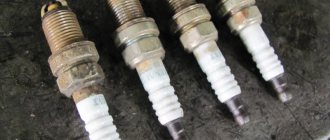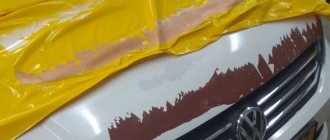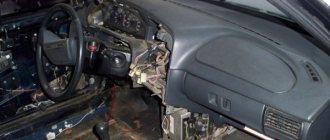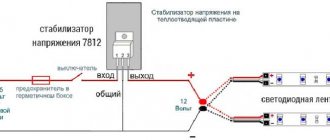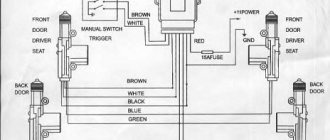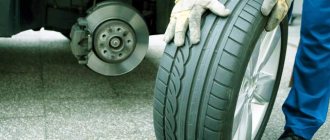Over time, each car receives traces of travel on difficult roads. In the most unexpected places, the paint begins to fall off, which is caused by various micro-impacts, encounters with bugs on the highway or with gravel from under the wheels. Removing chips is one of the keys to long-term operation of the car, since without this process the car will rust and require expensive welding repairs. You can use a standard set of materials or professional troubleshooting, but you cannot leave chips on the body.
In order for unpleasant chips to be completely removed, there is no need to do local painting and order expensive services at a service station. You can deal with this problem yourself and bring the car back to normal condition, postponing investments in its body. Touch-up paint allows you to tighten the layers of paint on the paintwork and prevent the destruction of the body. Even if the car is galvanized, without touching up the chips it will not be possible to maintain the integrity of the parts. In any case, it is worth monitoring the body and always promptly responding to any problems. It is not necessary to take transport to the station and pay a lot of money.
The main and inexpensive way to eliminate chips on a car body
Using a minimal amount of paint, your car can be completely renewed and protected. But don’t just pour material into the chip and think that rust won’t appear. Within a few days after such repairs, you will have to do better work, since corrosion will appear again. The only effective method is to eliminate the corrosion process. In this case, the car gets rid of rust and prolongs its life. The main stages of work are as follows:
- before touch-up, the damaged area is washed well so that there is no dirt, and also dried;
- Next you need to use a corrosion converter or solvent, but very carefully so that it does not get under the paintwork;
- You can clean the damaged area using chemically active substances and cotton wool or a harder object;
- then you can drop the soil and level it evenly over the resulting crater, this will make the work more efficient;
- then the chip is touched up directly - a drop of paint is applied to the damaged area and leveled.
https://youtu.be/TviJK-6XnRk
If the problem is on a horizontal surface, there will be no problems removing the chip. You can use a match or a cosmetic brush. If the damage is on a door or other vertical plane, touch-up painting will cause certain difficulties. The car must be kept in a dry place during this time so that the paint can dry. But within an hour after the work is completed, the car can be used. A day or two after completing the tasks, you can polish.
Restoring paintwork with a deep chip
The standard thickness of a car's paintwork is about 1 mm. But during body repairs it can reach up to several millimeters, and most of this layer is most often represented by putty. It is impossible to fill a deep chip with paint alone - you need to putty.
Chips on thick coatings must first be completely peeled off. You need to remove all loose particles, even if this even requires expanding the problem area several times. This can be done with a small screwdriver.
Usually deep chips reach the body metal. It is advisable to first treat it with anticorrosive agent, let it react, and only then continue repairs. If you have epoxy primer on hand, it wouldn’t hurt to “seal” the exposed metal with this compound as well.
Next you need to fill in the chip. Universal automotive putty is best suited for this. We dilute a small amount of the mixture with hardener and fill the chip. When the putty has completely hardened, it must be sanded with sandpaper (2000).
On a note
As a result of sanding the putty chip, the varnish around it will become matte. Nothing wrong with that. The dullness will go away with polishing.
If you have an airbrush, it is more convenient to do spot painting with it. You can, of course, do everything with a small brush, but an airbrush allows you to make a smooth transition, especially over varnish. The task is to completely cover the putty with paint. If it is too contrasting in relation to the paint, then you can first apply a primer that is similar in tone.
It is also useful to read: Features of painting a car body metallic
After applying several layers of paint, the spot at the chip site will be completely covered. In this case, you can go a little beyond its limits onto matte varnish. With an airbrush you can do this smoothly, fading to the periphery. When applying varnish, you need to cover the paint with it, but do not go over the gloss.
When the varnish dries, we will see the following picture: gloss at the chip site, around which there is a matte halo. This is completely normal, moreover, such a picture indicates that everything was done correctly. All that remains is to sand the area with 2000-grit sandpaper and polish until shiny.
On a note
It is important to wait until the varnish is completely cured. Otherwise, it will not grind as it should, but will begin to drag, leaving scuffs. You can drive for several days with a small stain on the body, waiting until the varnish is completely cured.
How to choose materials for restoring a car body?
Removing chips and restoring a car can be done quite simply using a ready-made kit. The kit includes paint, primer, solvent, and some manufacturers also offer various types of rust converters, for example, Rostkiller or Interpid. All of these kits can be useful for troubleshooting problems. But keep in mind that chips on the body cannot be completely painted over; they will still be visually visible. When choosing, you should consider the following features:
- touch-up of chips occurs constantly, so you can purchase more materials than you need now;
- The quality of paintwork materials and other elements should be selected to be high, and you should not skimp on the cost of the kits;
- the car will be restored only if all elements of the restoration kit are used;
- In order for the tint to be successful visually, you will have to perform a high-quality color selection.
Selecting paint materials by color for such a simple event is not easy. Especially if you decide to buy a ready-made car restoration kit. Paint manufacturers do not offer a large selection of such complex products. And buying a few grams of paint for your car is too unprofitable. It is better to purchase 200-300 grams of material and restore all the necessary parts. This way you can give your car a high-quality appearance and protect it from corrosion processes for a long time. Remember that touching up a chip does not mean complete protection against rust, so do not forget about such a need as anti-corrosion treatment.
Other options for repairing damage
For minor and not deep damage, it is enough to polish the damaged area. In addition, you can try to eliminate chips on your car with brake fluid, which needs to be rubbed on the damaged area.
Any method of eliminating chips can lead to errors, including the following:
- The appearance of melting as a result of applying the next layer, while the previous one has not yet dried.
- Dust settling during outdoor work.
- Uneven paint drying due to poor-quality paint or improper working conditions.
- Air bubbles on the surface due to exposure to a hair dryer or when using a fast-acting degreaser.
- The appearance of lines and smudges when using thick or too thin paint.
- Dullness when working in a room with high humidity, where chips were touched up.
- Grease stains appear when the painted area was poorly treated before the repair began.
- “Bare” areas occur when the surface is poorly degreased.
Any damage to the paintwork can be repaired with your own hands, but if you do not have the appropriate knowledge and skills, you should still trust the professionals. The deeper the scratch, the more effort will have to be made to remove it.
Timely repairs and elimination of minor damage will keep the paintwork in an attractive form, as well as ensure the safety of the body from corrosion and rotting. The cost of repairing scratches in auto repair shops depends on the degree of damage and complexity of the work, as well as on the volume of the damaged area. If you are thinking about how to touch up chips on a car yourself, then you should carefully approach all stages of the work and choose high-quality materials, and then the result will please you for a long time.
Even very careful drivers who have never been in an accident eventually discover that the paintwork of their favorite car is damaged. Chips appear on the hood, fenders and other surfaces - scratches of varying widths and lengths. Having noticed them, it is important to get rid of them as soon as possible, otherwise they will become deeper, reach the metal of the body, and provoke corrosion.
So what should you do, should you turn to service station specialists, having come to terms with the need for unplanned expenses? Not at all, because you can touch up chips on your car with your own hands right in your own garage. We will tell you how to do this step by step and what tools you will need, but first, a few words about the possible nature of the damage and the reasons for its occurrence.
Let's sum it up
It is not difficult to restore the body after minor damage on your own, so it is not always necessary to pay specialists for this. But if you want to maintain the aesthetic appearance of your car, it is better to contact a service for local or spot painting. Almost nowhere in professional service stations do they do touch-ups; they often perform higher-quality and more durable restoration processes.
If you started the car, there are a lot of chips and scratches on the body, rust will begin to develop in them. If the layer of paintwork begins to be undermined by corrosion, visible traces of internal destruction processes appear, the usual addition of paint will not be enough. You will have to completely clean the damaged area and remove the rust. Only after this can painting be done directly.
How to properly paint chips on a car
The appearance of chips on a car is a frequent occurrence. No driver is immune from this. You may be the best on the road, but the carelessness of another person behind the wheel may cause visible damage to your vehicle. High-speed travel and flying crushed stones and insects cause chips and cause serious damage. Corrosion processes, as a rule, are invisible to the naked eye and originate deep under the paint layer. When the machine is actively used, it is simply impossible to avoid damage. If various defects appear, it is better to immediately contact professionals for help. Don't put this off for too long. Remember: the sooner you contact, the easier it will be for the technician to make the damage less noticeable.
Chips are small scratches or breaks on the surface of the car. They can be different in depth, length and width. The paintwork of any car consists of several layers. Depending on how damaged each layer is, you need to choose the correct repair option. One of the most common mistakes made by car enthusiasts is to leave unnoticeable chips to fate. This is an extremely reckless act, since the main function of the paint coating is to protect the car from rust. Even the smallest scratch under the influence of external factors of nature will be characterized by the appearance of corrosion or rust.
Often the front part of the car is most damaged by chips. In the event of an emergency, the hood is the first to be hit. It is he who experiences the flight of flying stones from under the wheels of oncoming cars. Therefore, to protect yourself in such cases, experienced craftsmen advise covering the hood with a special anti-gravel film. Such protection is made of thin vinyl or polyurethane, and it does not at all spoil the external attractiveness of the car. It can create an excellent “shield” and enhance the protection of the coating for a long time.
how and with what to remove scratches on a car
What to do with deep chips on the surface
There is a difference between a regular scratch and a chip - this is how deep the damage to the coating is. Before you begin to repair the defect, assess the nature of the damage. They may affect:
- Only the top coat of varnish.
- Damage the varnish layer and even the metal of the structure.
If you decide to deal with this problem yourself, for this you will need:
- grinding machine with abrasive wheels;
- automotive primer and spatula;
- degreasers, varnish, paint and a special pencil;
- polishing pastes.
Then perform all the following steps step by step. To begin, clean the affected area of dirt by washing it well with soapy water. Then sand the damaged area using an abrasive machine. Apply a coat of primer. To make the surface as smooth as possible, cover it with a thin layer of polishing paste. After this, degrease the area, and only then paint over the chip.
How to get rid of shallow chips
In order not to lose the overall integrity of the body and not to reduce the value of the car if you suddenly want to sell it, you should learn how to properly get rid of even the smallest damage - shallow chips and scratches. It is much more expedient to deal with minor defects than to eliminate rotten areas of the body. If there are a large number of minor damages, there is no point in painting over each chip separately. In this case, it would be more appropriate to paint the entire body part. The process is painstaking, but not complicated.
If you can dismantle the body part yourself, separating it from the car, great, but if not, use tape and film, covering the remaining areas of the car.
- Wash and dry the damaged surface.
- Using a constant flow of water, sand down the paint with fine sandpaper.
- Dry the surface with a degreaser.
- Apply a new coat of primer and sand it down with fine sandpaper.
- Degrease the surface again and apply a coat of paint.
- If desired or necessary, cover the paint layer with a special varnish.
After some time, it is better to go through the procedure of polishing the painted part, and also polish the entire car. This way, you will be able to completely even out the color, making it monochromatic. Experts advise choosing paint from companies that use computer technology and will select the tone and shade with absolute accuracy. If you select low-quality paint, you may encounter a whole host of problems that will lead to complete paint of the body. Approach the moment of choosing paint responsibly. If all points are completed efficiently, your car will regain its former attractiveness.
If there is no need to eliminate many chips, the procedure will be much simpler and easier. In this case, it is very important to choose the color of the paint so that the chip stain does not differ from the general background of the coating after painting. When you are dealing with a very small chip, use a match or small brush to apply the paint after cleaning the surface first. Remember that you should not apply varnish on top of the paint - this risks making the chipped area more noticeable against the general background. To get rid of shallow chipped damage, you will need on hand:
- varnish and degreaser;
- special polishing paste;
- sanding paper for sanding;
- pencil for filling in scratches.
When the damage is minimal, returning it to its former attractiveness is not difficult.
If the chip affected the metal and caused corrosion
If a chip has affected the metal coating and caused corrosion, the process of eliminating such a defect will take a long time and require a responsible approach. Initially, to do this, you should repair the body and then deal with the chips themselves.
- Clean the affected area, remove the rust down to the metal.
- Wash and degrease the surface. If necessary, use sandpaper to clean the area where the chip appears.
- Apply primer and sand the layer with 1000 grit sandpaper. Paint the area. If necessary, you can coat the chipped area with varnish.
When painting, try to act extremely carefully and not touch the rest of the car with the spray. To enhance safety precautions, use masking tape and film.
Remember that the process of painting a body requires special attention and preparation. It is better to eliminate the problem at an early stage than to allow a more serious one to arise by postponing the process for a long time. If you notice a chip on the surface of your car, it is better to take the necessary measures immediately. There is nothing complicated about this problem, and if you really want to, you can successfully fix the problem yourself. If you are afraid of ruining the attractive appearance of your car, then it would be better to turn to professionals for help.
how to clean car interior
Video: how to remove scratches and chips on a car
howtogetrid.ru
How and with what to paint chips on your car yourself?
Tags:How to apply paint and varnish
Even with careful driving, scratches and other damage often appear on the surface of the car. This happens due to the impact of pebbles or other objects while driving.
Some motorists are negligent about such defects, which later results in serious financial investments to eliminate corrosion. How to repair chips on a car body with your own hands? How to touch up chips on the body and do local reconstruction in case of more serious damage?
Chips on the hood of a car
Not significant defects
Repair of chips is recommended to be done in specialized salons. But specialists process the entire part of the transport, which, of course, affects the cost of the procedure. Therefore, drivers are trying to learn how to properly paint over scratches on their own.
If you need to do car body repairs yourself, it is recommended to understand the details before doing so. You need to understand how to touch up chips on a car so that it is not noticeable and professional.
If the scratches on the vehicle body are not significant, then it is better to use a special pencil marker or polishing agent. For minimal damage, simply apply the product to the surface and rub in thoroughly. The marker will paint over defects on the car of several millimeters.
Pencil for removing scratches on cars Fix it pro
How to paint over chips on vehicles if they are not superficial? This is done as follows:
- The damaged area must be thoroughly washed and degreased with a special car cleaner.
- Then apply primer and let it dry.
- The next step is to apply paint that matches the color of the car body.
Today small bottles of dye are sold. Touching up chips will be quite easy, since there is a special brush that is used to treat the damaged area.
Bottle with dye
You can find the paint markings in the vehicle registration certificate. Car dealerships will help you choose the color if you cannot determine the paint shade yourself. To do this, a color spectrum is produced. Sometimes the required number cannot be found. In this case, use the closest shade and try to blend it lightly so that it does not catch your eye. Partial touch-up will not take much time and money.
Car body protection
The problem of protecting the painted surface of the body from chips and scratches is very relevant. After all, everyone wants to preserve the original appearance of the car, but small details on the road surface make it difficult to do this.
Painting can even be ruined at the car wash, where if all the rules are violated, it can be easily washed off along with the dirt. Quite a lot of means of protection have been developed, but not all of them are effective.
Many people believe that polishing is enough to protect the car from scratches, but this is not the case. The coating will wash off faster than the paint itself.
However, there is still protection, just from dirt particles. If you still think that polishing is an excellent protection against mechanical stress, even from stones, then you are wrong.
The so-called “muzzle” can also be considered an ineffective means of protection. Over time, sand and dust get underneath it, which periodically eats away small holes.
Plastic deflectors also cause harm over time for the same reasons, even though the device initially performs its function.
The above means do not provide the desired result, but more effective means for providing body protection are still available on the market.
One of them is a “liquid cover” , which has a certain composition.
After applying it to the body, according to the rules specified by the manufacturer, a long-awaited protective coating appears on the surface, which looks like a film.
If you do not follow all the technological aspects of application, then it will not be able to fulfill its purpose.
Once you've driven through bad sections of the road and it's time to remove the protective layer, you can easily remove this layer without damage or marks on the surface.
Another reliable means of protecting car paint from road gravel in this case is armoring film. Just be prepared to pay much more for it than in previous cases.
The film is transparent, so you may not notice it on the car. Experts often give recommendations regarding this particular protection option, and some manufacturers even use it at the factory.
This lenka will last for several years. The service life depends directly on the operating conditions of the car, driving style, and usual speed.
Over time, you will be able to remove it, but this must be done carefully; it is better to contact a specialist.
The most common options for car body protection have been presented to you. You can evaluate all their advantages and disadvantages yourself.
After weighing all the recommendations, you will come to the right decision and choose the best protection option for your vehicle.
How to remove scratches and touch up chips on a car
Unsightly chips on the hood can worsen the car owner’s mood, since they not only spoil the appearance of the car, but also, if the paint chips extensively down to the metal, they threaten the appearance of corrosion. In this case, only painting the damaged areas will help. It is almost impossible to avoid minor defects in the paintwork of a car, every car enthusiast knows this.
Many people cover the car body with anti-gravel film to protect against chips and scratches. But before you do this, any existing chips and grooves should be removed from the car. How to paint over minor paintwork defects, how to repair a car body yourself? Which paint protection gives the best results?
Return to contents
Types of damage to car paintwork
Chips on the body are formed from impacts from gravel, crushed stone, and debris flying out from under the wheels of oncoming cars. Damage can be divided into the following types:
- superficial - when only the varnish layer and the surface of the soil are affected;
- paint chipping and deep scratches appearing, exposing the metal.
Shallow surface chips require immediate attention no less than chipped paint, as they threaten in the future more extensive destruction of the car's paintwork with exposure of metal and the development of corrosion. You can remove such chips and scratches yourself using special car body care products.
In such cases, painting is not required; defects can be painted over with a liquid product or a coloring pencil. This is a fast and inexpensive method, easy to use. But its disadvantage is that surface defects will have to be touched up frequently, since after one or two vehicle washes the composition is washed off.
In the second case, if chips on the body reveal bare metal, more serious repairs of the car are required. Such defects appear from impacts of stones or due to deep scratches that were not processed and painted over in time. Removing this type of damage requires a lot of effort and expense.
Painting when chipped to metal is a necessary procedure.
Repairing a car body with your own hands begins with preparing the tools and tools necessary for the process. Removing chips down to metal on a car involves using the following tools:
- sanding paper P600; P1000; P1500, P2000;
- sanding block;
- a grinder or drill with a set of grinding wheels;
- putty knife;
- spray gun.
In addition, you need to purchase consumables:
- putty, primer;
- paint, varnish;
- white spirit, xylene.
Having prepared everything you need, you can begin the process of removing chips from the vehicle’s paintwork.
Return to contents
Painting the damaged area
Do-it-yourself car body repair consists of two stages:
- site preparation;
- painting.
In order for chip removal to be successful, painting to be of high quality, and film protection to be reliable, it is important to properly prepare the damaged area of the car body. Before touching up the chip, you need to wash the car and remove rust (if any). It is necessary to prepare a section of the car in order to then paint it with your own hands in the following sequence.
- Using a grinder, drill with wheels or sandpaper, begin to rub the damaged area down to the metal or chip depth level. You should get a smooth surface. Clean the chipped area with P600 sandpaper, and sand the paintwork around the chip with P1000 grit abrasive. Degrease the area with white spirit or xylene.
- The next step is to apply putty. Use a rubber spatula for this. After the composition has dried, sand the surface with P1500 sandpaper until it is even and smooth.
- In order for painting to give a high-quality result, apply a layer of primer, which, after drying, must be sanded with fine-grained sandpaper soaked in water.
Now the site is ready for the next stage: local painting of the car body. It is important to choose a color that exactly matches the main color of the car. This can be done by VIN code, using a fan of colors, or simply by contacting a colorist at a car repair shop. Having chosen the desired shade and purchased auto enamel, proceed to painting the prepared area. Use a spray gun for this.
This procedure for removing chips and scratches is more time-consuming and expensive, but it is this kind of repair that provides the most reliable result. And if there are deep defects, there is no way to do without repainting.
To ensure that the processes described above go smoothly and without surprises, when you repair chips and scratches on the car body, follow all the necessary recommendations and instructions. If you decide to neglect something, for example, to save on materials, drying time and painting, then the following problems may arise:
- uneven drying of the enamel, in which spots or streaks of soil appear;
- drips of paint and varnish that appear when the paint is too liquid or the previous layer is not completely dry;
- dullness; This problem can occur with an increased content of hardener and air humidity in the room.
So repairing chips on a car is not as simple a task as it seems at first glance. But if you know how to use tools, correctly apply primer, putty, auto enamel, and strictly follow the instructions for using paintwork materials, then removing chips will not be an impossible task for you.
Return to contents
Comparative characteristics of protective anti-gravel film
In order for the car body, the repair of which was carried out by yourself, to last as long as possible, the paintwork must be protected. This could be a layer of varnish applied to the enamel with your own hands. This protection will protect the car body from minor chips and scratches. But there is a more reliable option for protecting the car body from the appearance of new chips - anti-gravel film.
You can paste it over the body using a special glue or use a self-adhesive film. Today, the two most popular types of materials are vinyl and polyurethane. Each of them has advantages and disadvantages. Vinyl film has the following characteristics:
- bends well, which gives it advantages for use on complex curves of the surface of the machine body;
- resists UV radiation;
- versatility: protects headlights, optics, mirrors from chips;
- low cost of material.
Vinyl film does not have very good strength indicators due to its thinness, in addition, it reacts poorly to cold: it hardens and becomes brittle. In turn, polyurethane protection has the following advantages:
- a thicker and more durable film layer;
- high wear resistance of the material;
- will last longer than vinyl film.
But some of its advantages are also disadvantages. The thickness of the material does not allow it to be used to completely protect the body, since it is impossible to cover structures with complex surfaces with such a film without making cuts that cannot be masked. Polyurethane film is glued to the front parts of the hood, bumper, and mirrors.
krasymavto.ru
Repair work
Work to eliminate defects is carried out in stages, everything is done measuredly and without haste.
1. Examine the places that were subject to deformation; they need to be cleaned. To do this, use detergents like white spirit.
2. Decide on the type of coverage. There are not many options on the car market: acrylic, which we are used to seeing on domestic cars, acrylic for varnish, and also metallic.
If you cannot determine what kind of coverage you have, then use one experiment. Use polishing paste and use a cloth to buff off a small area.
If there is dirt on the fabric, it means that varnish has been applied to the coating. If there is a little paint on the rag, then most likely no varnish was used during coating. This will make it easier to decide what is more suitable for you to eliminate paint damage - acrylic or synthetic paint.
3. If elements of rust have already begun to appear at the site of the defect, then it is worth cleaning it. In this case, it is better to use a file, a knife, or chemicals.
4. To ensure that paint and varnish adhere better to the surface, it is recommended to use sanding paper.
5. After rubbing off the rust, apply a primer, preferably a two-component one. A couple of drops is enough in this case. The primer is applied with a brush or a match, depending on the area of the surface being treated.
The procedure is repeated again every quarter of an hour. Speed up the drying of the material by using a hairdryer; only when the soil is completely dry can you treat the chips with paint.
6. Stir the paint before applying it. If the surface is acrylic, then the procedure will not take much time; you need to apply a thin layer of paint every 15 minutes.
Since shrinkage occurs, there will be more than one layer. The paint is worn until a small bump forms.
7. Grinding will help smooth out the resulting bump. It is necessary to level it with the surface of the car. To protect the paint next to the working surface, it is necessary to apply a small layer of nitro putty.
Sanding is carried out only after the applied materials have dried. Prepare yourself a piece of sandpaper for work with a grain size of P1500 .
When working, use water to rinse the sandpaper. Watch the lump as it disappears and do not press too hard.
When the tubercle begins to noticeably decrease, it is worth using a different size sandpaper - P2000 . upon completion of the work, you will already have a smooth matte surface. To get the long-awaited result, you can immediately start polishing.
By following the basic rules, you can get rid of defects on your car. But there is a possibility that doing this for the first time, you may do something wrong.
Let's consider what kind of troubles can occur after surface treatment has been carried out.
